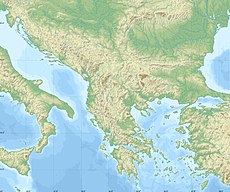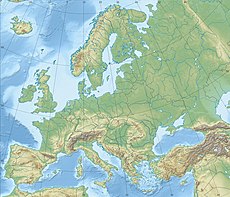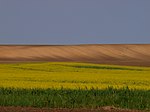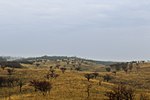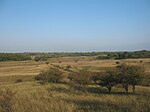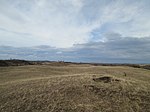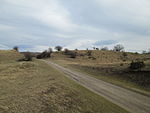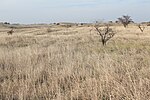Deliblatska Peščara
| Deliblato Sands | |
|---|---|
| Делиблатска пешчара Deliblatska peščara | |
 Deliblato Sands | |
| Floor elevation | 250 m (820 ft) |
| Area | 300 km2 (120 sq mi) |
| Geography | |
| Location | Banat, Vojvodina, |
| Coordinates | 44°53′01″N 21°05′33″E / 44.88361°N 21.09250°E |
Deliblato Sands (Serbian: Делиблатска пешчара, romanized: Deliblatska peščara; Hungarian: Delibláti-homokpuszta) is a large sand area covering around 300 km2 (120 sq mi) of ground in Vojvodina province, Serbia. It is located in southern Banat, situated between the river Danube and the southwestern slopes of the Carpathian Mountains. The sands are named after the village of Deliblato,[1] in the municipality of Kovin. Its main masses are elliptical shaped hills with steppe grassland plains and steppe forests.
The Deliblato Sands is the largest sandy terrain in
It is referred to as the "European
Geography
The Deliblato is an expanse of Aeolian processes with significant dune-like relief made of powerful sandy deposits. It is a unique feature in this part of the world as the largest exemplar of the true sandy relief. Dunes are 70 to 200 m (230 to 660 ft) tall.[1] Southeast of the sands is the Kraljevac lake, one of the reservoirs formed around the edges of the region, in an effort to stop moving of the sand. There are floating peat islands on the lake's surface, where numerous waterfowls are nesting.[2]
Labudovo Okno
Southern section of the sands, which reaches the Danube, is known as the Labudovo Okno. It has been declared a Ramsar wetland in 2006. The section covers an area of some 40 km2 (15 sq mi) and includes marshes, ponds, meanders, river islands of Žilovo, Čibuklija and Zavojska Ada, meanders of the Karaš river and the submerged mouth of the Nera into the Danube. It is one of the most important migratory birds habitats in Serbia.[1]
Wildlife
The Deliblato Sands is rich in
A total of 200 animal species inhabits the sands. Rare
Human history
Remains from the Bronze Age were discovered in the locality of Židovar. Other localities (Đurica, Grebenac, Veliki Grad, Mali Grad) contain remains of the habitation from the 13th century BC to the 1500s and 1600s. Roman period is represented with the trench near Kovin (Rimski šanac).[1]
In 1789, Austrian authorities, which controlled the area at the time, dispatched forest engineer Franz Bachofen from Timișoara to conduct measurements of the sands and complies a report on how to "tame" the sand. At the time, strong winds and storms would carry the sand from Deliblato all the way to Vienna and Pest.[1] According to the popular myth, Austrian empress Maria Theresa ordered for the fixing of Deliblato after wind brought some sand into her plate while she was eating soup.[2] After a decade of work, Bachofen reported that the sands cover an area of 406.60 km2 (156.99 sq mi), out of which 168 km2 (65 sq mi) is covered with loose, free sand. In order to immobilize the sand, Bachofer drafter a forestation plan, which was accepted in 1818. Since then, almost 300 km2 (120 sq mi) of the sands was forested, but also 250 km2 (97 sq mi) got burned in time in three catastrophic fires caused by the human negligence.[1]
The sand was used as a hideout by the Yugoslav Partisans during World War II. They used to build base camps and dugouts where they were hiding after the anti-German actions. Out of numerous temporary hideouts, only one is preserved today. It was an improvised hospital at the locality Čardak. A monument dedicated to the Jews who were transported from Belgrade and executed in the sands by the Germans during the occupation, is also located here.[1]
After the war, numerous
"Čardak" was then adapted into the educational-recreational center. In March 2020, the provincial administration decided to use it as the camp for the
In total there are some 800 households, weekend-houses or rooms in excursion complexes in the sands. This includes a weekend settlement with 20 bungalows, built by the former Glass Industry Pančevo, which is today left to the elements. The chronic problem in the sands is the lack of drinking water.[5]
Characteristics
Extensive
Locality of
An artistic colony "Deliblatska Peščara" is organized annually. In decades, until 2019, 432 artists participated in workshops, producing thousands of works, out of which 1,288 were given to the town of Pančevo.[1] Established in 1969, the colony is centered at Devojački Bunar.[6]
In popular culture
The sands was used as a filming location for numerous international and Serbian films: Genghis Khan (1965), I Even Met Happy Gypsies (1967), It Rains in My Village (1968), Who's Singin' Over There? (1980), The Elusive Summer of '68 (1984), Battle of Kosovo (1989), The White Suit (1999), St. George Shoots the Dragon (2009) and some 10 other films and co-productions.[1]
Gallery
|
See also
- Subotička Peščara
- Zagaj Hills (Zagajička (Zagajska) Brda)
- Pannonian tourism region in Serbia
- Oleshky Sands
References
- ^ a b c d e f g h i j k l m n o Olga Janković (2 June 2019). "Занимљива Србија: Делиблатска пешчара - Немирни песак европске Сахаре" [Interesting Serbia: Deliblatska Peščara - Restless sand of European Sahara]. Politika-Magazin, No. 1131 (in Serbian). pp. 20–21.
- ^ a b c Marina Vulićević (20 September 2022). "Tamo gde je sniman film "Ko to tamo peva"" [Where the movie Who's Singin' Over There? was filmed]. Politika (in Serbian). p. 12.
- ^ a b "Serbia travel - Deliblato Sands". serbia.travel. Archived from the original on 2011-09-30. Retrieved 2011-04-14.
- ^ Olga Janković (28 March 2020). Чардак ипак карантин, а не центар за мигранте [Čardak quarantine after all, not the migrants' center]. Politika (in Serbian). p. 17.
- ^ Olga Janković (31 July 2022). Пресушио Девојачки бунар [Girls' well dried out]. Politika (in Serbian). p. 12.
- ^ Olga Janković (20 July 2019). Скраћено издање "Делиблатског песка" [Short edition of "Deliblatski pesak"]. Politika (in Serbian). p. 13.
External links
- "Deliblato sands – the European Sahara". serbia.com.
- "Deliblato Sands–Zagaj Hills / Deliblatska peščara–Zagajička brda". explore-serbia.rs.


